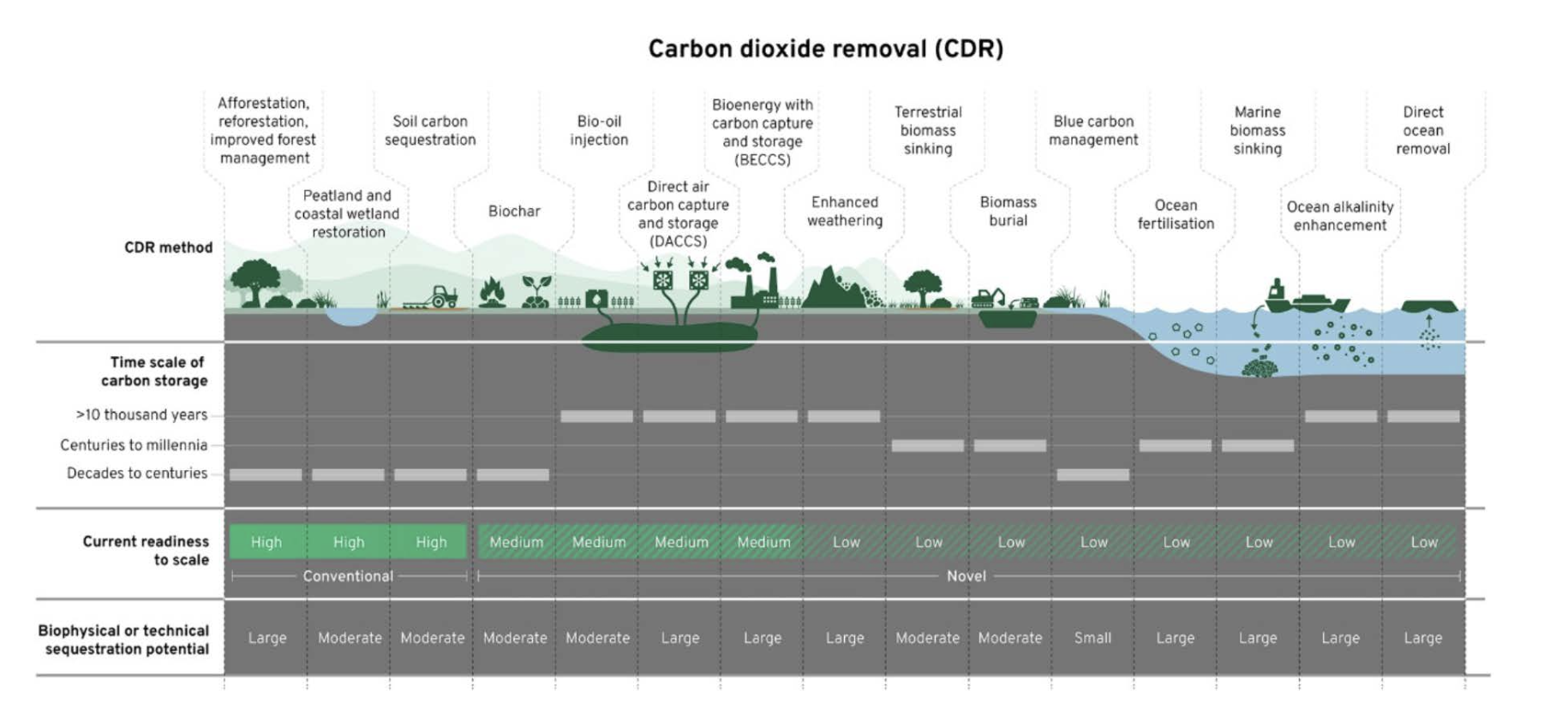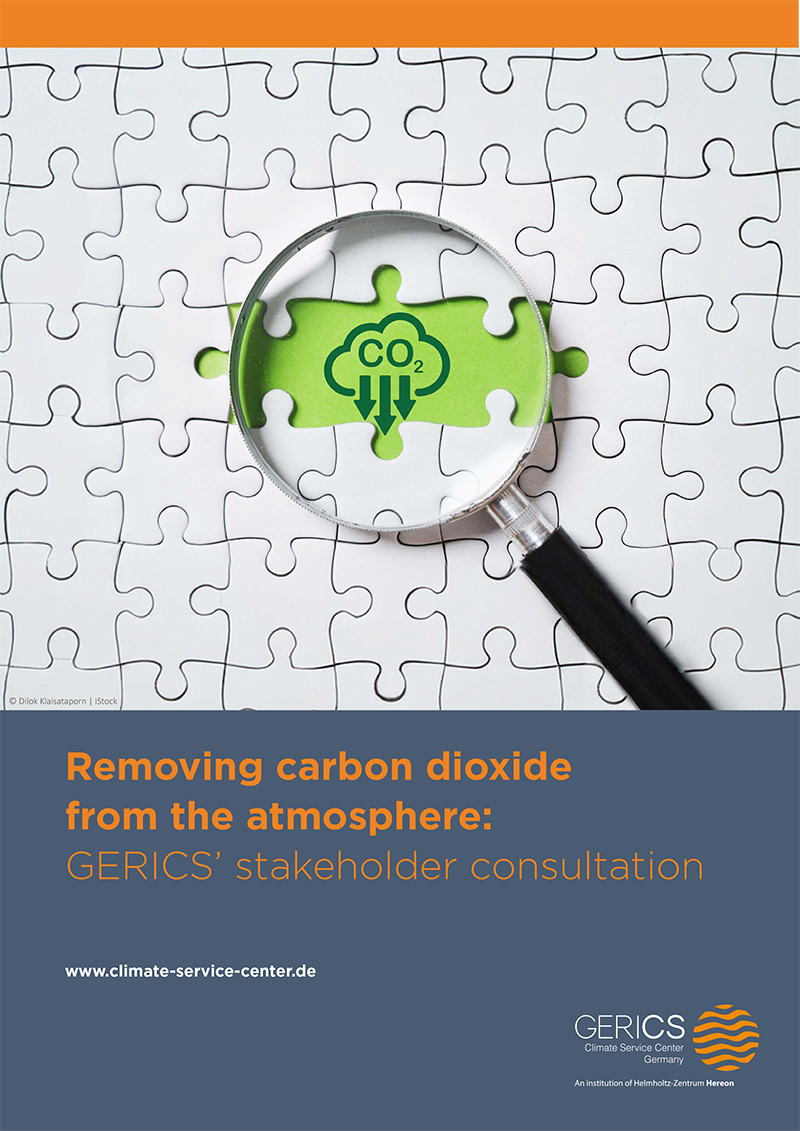Many countries aim to achieve the net-zero emission target. This means that any human activity releasing greenhouse gas emissions into the atmosphere must be counterbalanced by an equivalent amount being removed. But how is that supposed to work? And what do the public and stakeholders think of it?
First and foremost, greenhouse gas emissions must be reduced as much as possible. However, for the emissions arising from hard-to-abate sectors, such as cement production or animal husbandry, removing carbon dioxide (CO2) from the atmosphere has become an essential part of the pathway to reach the net-zero emissions target.
Carbon Dioxide Removal refers to human activities aiming at capturing CO2 from the atmosphere and storing it for as long as possible, ideally forever. There are many ways to remove CO2 from the atmosphere. The methods have different levels of readiness, potentials of mitigation and durability. Researchers group the methods into two broad categories: conventional and novel methods. Conventional methods both capture and store carbon in the land reservoir. This group includes afforestation/reforestation, increasing soil carbon in croplands and grasslands, peatland and wetland restoration – just to mention a few. Carbon Dioxide Removal methods, which store captured carbon in geological formations, oceans or products belong to the category of novel methods.
Technical advances alone cannot guarantee a successful implementation of both conventional and novel carbon dioxide removal methods. Multiple factors, ranging from legal frameworks to financial conditions, influence their deployment. In particular, public acceptance, including from those implementing the methods, is crucial. Methods that lack public approval face major challenges and, in some cases, may be impossible to implement. Therefore, understanding the perception of the public and implementers and involving them in the development process is crucial for the effective implementation of these strategies.
At GERICS, researchers are currently running two projects that focus on this precisely. Within the DACStoreE project, GERICS focuses on the public perception of a novel Carbon Dioxide Removal method called Direct Air Capture and Storage (DACS). Within the project CDRSynTra GERICS investigates what agricultural implementers think of conventional and novel Carbon Dioxide Removal methods and what information they are missing.

DACSTorE Project
The DACStorE project is a cooperation between seven German research institutes. The goal of the project is to boost the sustainable development and implementation of DACS technologies in Germany.
DACS as its name implies, is a technology designed to capture CO2 directly from the atmosphere. To capture CO2, air is passed through chemical or membrane filters that selectively trap CO2 molecules. Once captured, the CO2 is compressed and transported to storage sites. The CO2 is then injected into the ground and stored at least 800m below the surface in geological formations. This type of storage has the potential to store CO2 for millennia. However, DACS is energy-intensive, and its effectiveness depends on the availability of low-carbon energy sources. While still in its early stages of deployment, DACS is considered a crucial tool for achieving net-zero emissions.
The project is being carried out by four research groups. One research group is currently performing a technology assessment and finding answers to questions such as: What are the impacts of emissions from DACs facilities? And how sustainable are the different DACS systems? Their goal is to promote the sustainable design of DACS facilities. Another research group is investigating DACS technologies themselves. This group is comparing three different methods to filter CO2 from the air and capture it. The capture methods are based on processes such as chemical sorbents, membrane filters, porous materials, and electrochemical reactions. Their goal is to increase the efficiency of DACS, to have a deep understanding of the advantages and disadvantages of each approach, and to promote informed method selection. A further research group is building a communication bridge between the project researchers, the public and relevant stakeholders. Their goal is to provide access to the reports, open data and developed open-source models developed by the project.
GERICS is involved in the research group that focuses on the social elements influencing the scale-up of DACS. This group is searching for answers to questions such as what laws and regulations are required to enable DACS and which regulations are currently inhibiting its deployment? GERICS work is about the acceptance of DACS technologies in Germany. GERICS is currently mapping the opinion of different stakeholders and, especially, of society at large regarding DACS.
Our team is implementing two approaches to include society’s opinion in the development and implementation of DACS in Germany. First, an online survey specially designed to understand what exactly do people like and dislike about DACS. The survey, in German, could be answered by anyone living in Germany. People were strongly encouraged to give their opinions on DACS. After a three-months campaign almost 2,000 residents answered the survey.
The next step is a series of workshops in which GERICS researchers will engage members of different stakeholder groups, such as the industry, politics, and society at large. During the workshops, the opinions collected during the survey will be further explored. Citizens will be able to engage other groups in open discussions and exchanges about the conditions required for the large-scale implementation of DACS in Germany.
This piece of the puzzle is particularly important as some communities might be open to supporting DACS but only under certain conditions. The reasons to reject or support can be broad, and sometimes they can be a combination of several factors. The opinions of the public should be, therefore, considered before projects are designed and developed. This will serve to guarantee fair conditions for the involved parties but especially for people living close to DACS facilities.
CDRSynTra Project
CDRSynTra is one of ten consortia belonging to the biggest research program CDRterra on land-based Carbon Dioxide Removal methods in Germany, which is funded by the BMBF. As a partner of the CDRSynTra consortium, GERICS is currently conducting a case study in the agricultural sector in Northern Germany.
The agricultural sector is increasingly moving into the spotlight of becoming an active player in applying conventional and novel Carbon Dioxide Removal methods. Conventional methods aim for plants to remove additional CO2 from the atmosphere and store the carbon they contain first in new biomass and then, if possible, long-term in the soil. This can happen by new planting – for example, in periods where no plants have been cultivated to date e.g. the cultivation of cover crops. Their underground biomass can significantly increase the humus content of the soil. Another option for increasing the photosynthetic and CO2 storage capacity of plants is to establish agroforestry. Agroforestry is the growing of trees and shrubs with crop and livestock farming on the same piece of land. The conversion of carbon contained in additionally produced biomass into carbon-rich material – so-called biochar – counts as a novel method for removing additional CO2 from the atmosphere. Biochar applied on fields can have positive impacts on soil quality.
In research, little is known about the views of the local agriculture stakeholders who would have to implement such measures. To counteract this, we carried out a case study in Northern Germany with agricultural stakeholders whom we interviewed to answer the following three questions: How familiar are agricultural actors with the concept of removing atmospheric carbon? What information do they need? How would they like to receive the missing information?
Between January and July 2023, we held 29 interviews with 34 participants, including farmers, farmers’ associations, start-ups producing biochar, and governance bodies such as administrations and state ministries.
In general, we have found that the concept of Carbon Dioxide Removal has entered the agricultural sector and it is gaining awareness. Farmers expressed more informational needs than representatives of farming associations or from regional administration level. Although our interview guide was open to all Carbon Dioxide Removal methods, the discussions focused around three single CDR practices: soil carbon sequestration, agroforestry, and biochar.
To identify holistically what the questions and information needs the agricultural actors have, we used the six dimensions of the CDRterra assessment framework as an analytic framework. Interviewees raised the need for knowledge across all six dimensions. Most of the statements that led to open questions related to the dimension of economic efficiency and system benefits, followed by the dimensions of mitigation effectiveness. The questions regarding the dimensions of technological conditions, environmental impacts political feasibility and social aspects were of equal importance.
The most expressed question by all interviewees was related to economic aspects: How can it be ensured that the use of Carbon Dioxide Removal practices is economically beneficial? It was clear from all the comments that the deployment of Carbon Dioxide Removal practices must pay off for farmers. Reference was often made to the direct financial reward, but also to co-benefits of Carbon Dioxide Removal for the public – and how it could be remunerated.
Within two projects, GERICS is currently exploring stakeholders’ perspectives and knowledge needs regarding DACS and carbon dioxide removal practices in the agricultural sector. This is a necessary measure to facilitate its implementation. With our studies, we pave the way for an intensive exchange between researchers and local stakeholders to work together to push forward Carbon Dioxide Removal in Germany.


